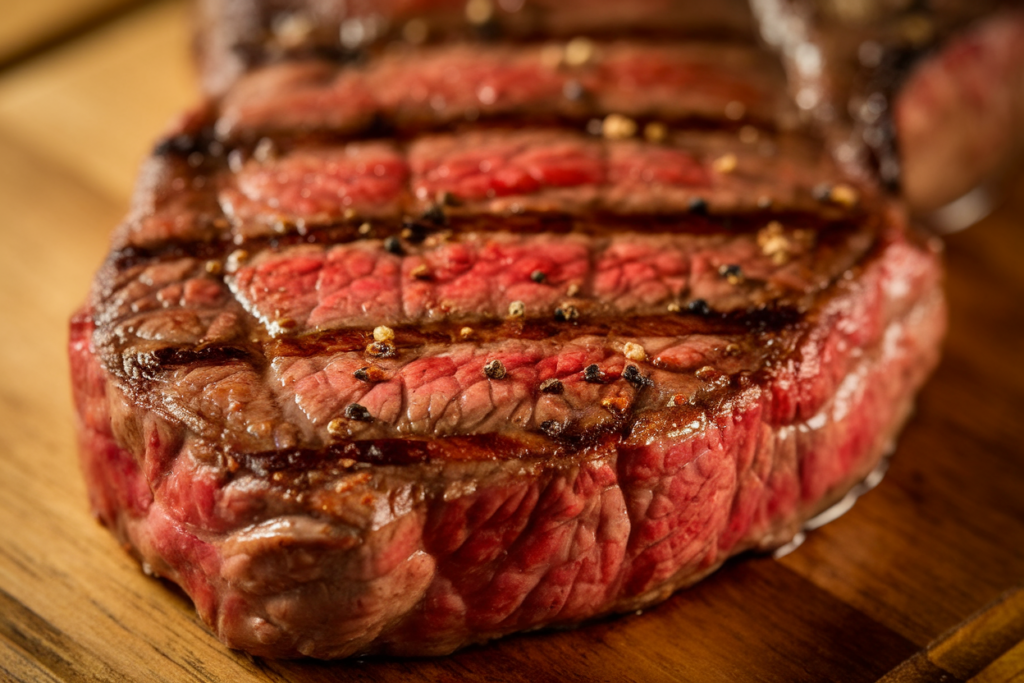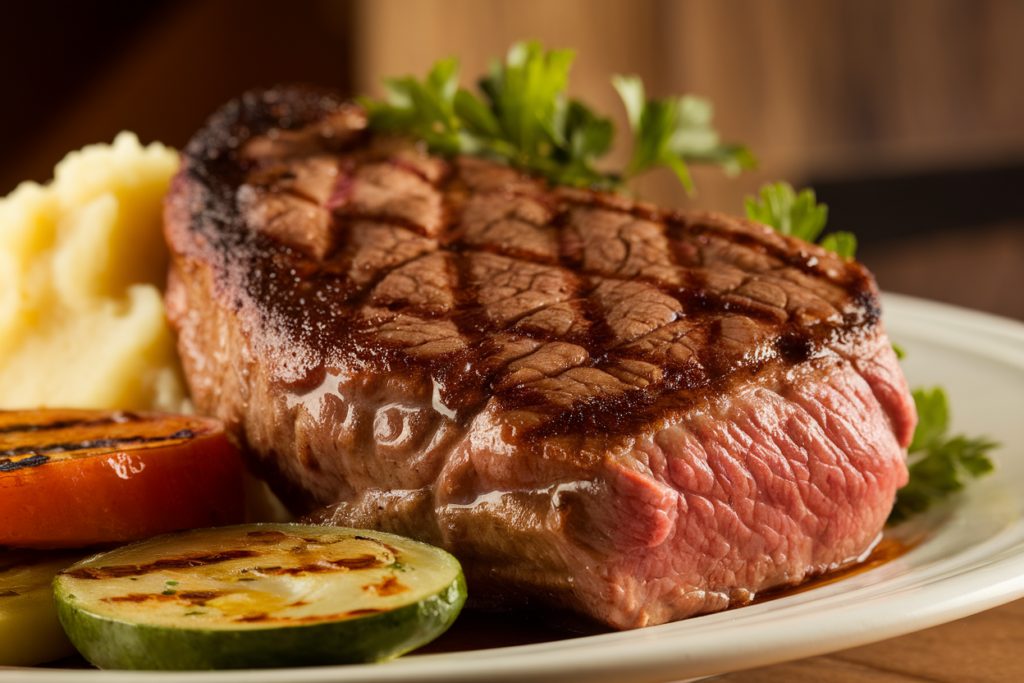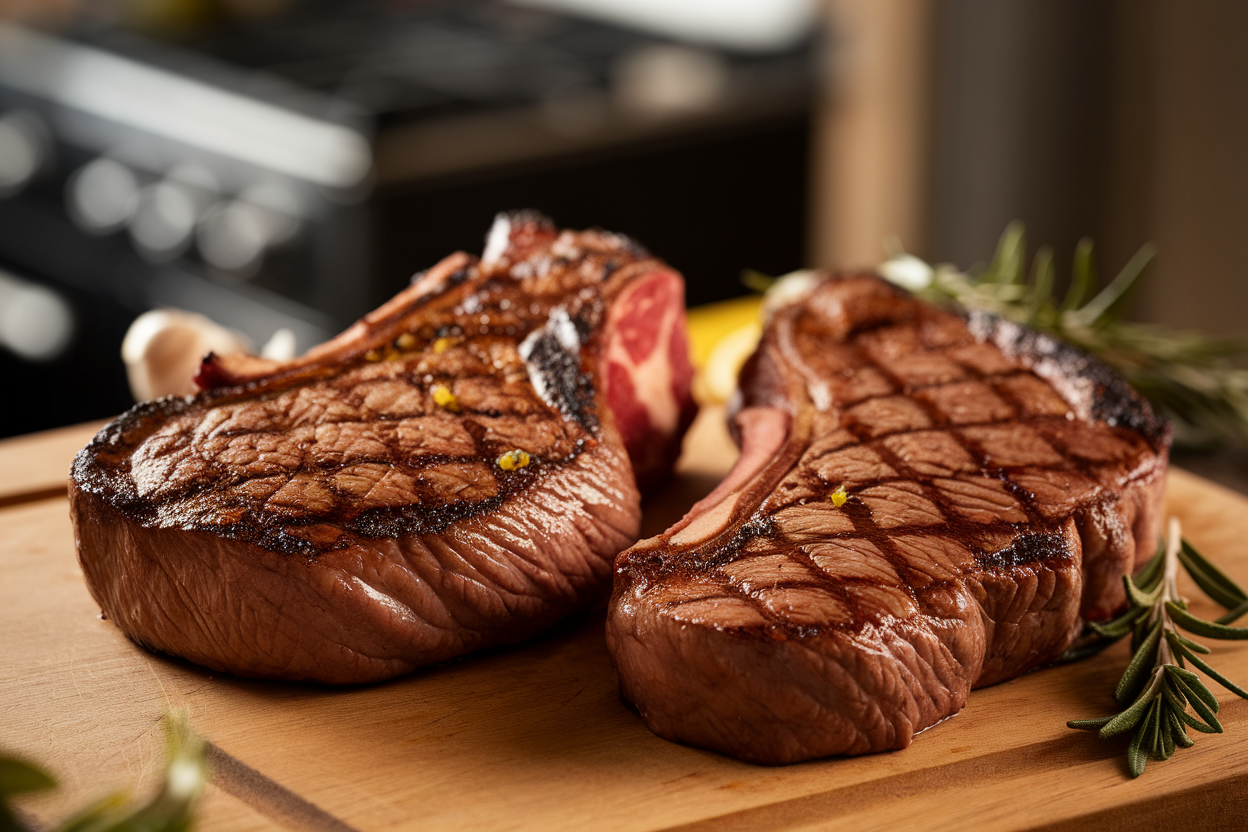Steak enthusiasts, this one’s for you! If you’ve ever looked at a chuck eye steak and wondered if it’s the same as ribeye, you’re not alone. These two cuts share a lot in common, but they also have key differences that set them apart. Let’s unravel the mystery together and explore everything you need to know about chuck eye and ribeye steaks.
Introduction to Chuck Eye Steak and Ribeye
Both chuck eye steak and ribeye are beloved by meat lovers, but for different reasons. Ribeye is often considered the gold standard of steaks—tender, juicy, and full of flavor. Chuck eye steak, on the other hand, is a budget-friendly alternative that’s gaining popularity.
Why the nickname “the poor man’s ribeye” for chuck eye? Because it comes from a similar part of the cow and shares many of ribeye’s characteristics at a fraction of the price.
What is Chuck Eye Steak?
Chuck eye steak is cut from the shoulder area of the cow, specifically near the fifth rib. It’s a close neighbor to the ribeye, which explains its similar marbling and flavor. However, it’s slightly less tender because it comes from a more muscular area.
This cut is rare—you’ll only get a few chuck eye steaks per cow. That’s why you might not see it at every grocery store or butcher shop. But when you do, it’s a steal for the price!
“Chuck eye is like finding a diamond in the rough—it’s affordable but still shines when cooked right.”
What is Ribeye Steak?
Ribeye steak is the superstar of beef cuts. It’s taken from the rib section, between the sixth and twelfth ribs, and boasts beautiful marbling. This fat gives ribeye its signature buttery texture and rich flavor.
Whether you’re grilling it, pan-searing it, or broiling it, ribeye is almost impossible to mess up. That’s why it’s a favorite for special occasions or anytime you want to treat yourself.
Differences Between Chuck Eye Steak and Ribeye

Location on the Cow
The first big difference lies in where each cut comes from. Ribeye is taken from the rib primal, a tender area that doesn’t get much exercise. Chuck eye comes from the chuck primal, which is closer to the shoulder and works harder, making it slightly tougher.
Flavor and Tenderness
Ribeye is famously tender with a melt-in-your-mouth quality. Chuck eye, while flavorful, has a bit more chew. Think of ribeye as the silky scarf and chuck eye as the cozy sweater—both are great but serve different purposes.
Cost and Availability
Price is another major distinction. Ribeye is a luxury item, while chuck eye is a budget-friendly option. However, chuck eye can be harder to find since only a few cuts are available per cow.
| Aspect | Chuck Eye Steak | Ribeye Steak |
|---|---|---|
| Tenderness | Medium | High |
| Flavor | Beefy and Rich | Buttery and Juicy |
| Price | Affordable | Expensive |
| Availability | Limited | Widely Available |
Similarities Between Chuck Eye Steak and Ribeye
Shared Characteristics
Both cuts are flavorful and versatile, making them perfect for grilling, pan-searing, or broiling. They also share some marbling, which adds juiciness and enhances the taste when cooked.
Cooking Methods
The cooking process for these cuts is almost identical. Both benefit from high-heat methods like grilling or searing to lock in their flavors. Whether you’re a fan of medium-rare or medium, a quick sear on both sides does the trick.
Pro Tip: Use a meat thermometer to ensure your steak reaches the perfect temperature. Aim for 135°F for medium-rare.
Common Problems When Choosing Between Chuck Eye and Ribeye
Misidentifying the Cuts
Chuck eye and ribeye look similar, so it’s easy to confuse the two. This is especially common for first-time buyers who may not know what to look for.
Concerns About Quality
Some people worry that chuck eye won’t deliver the same premium experience as ribeye. While it’s true that chuck eye is less tender, proper cooking can make it shine.
Budget Constraints
Ribeye is undoubtedly pricey, which can deter some shoppers. Chuck eye offers a more affordable alternative, but it’s not always available.
Solutions to Common Problems
How to Identify Each Cut
Ask your butcher for help! Chuck eye is typically labeled as such, but if you’re unsure, look for a steak cut from the fifth rib. Ribeye, on the other hand, will always come from the rib section and often has “ribeye” clearly marked.
Cooking Tips
Chuck eye benefits from marinating or slow cooking to enhance its tenderness. Ribeye, being naturally tender, shines with simple seasoning—salt, pepper, and a touch of olive oil.
Alternative Options
If you can’t find chuck eye, consider other affordable cuts like flat iron or Denver steak. They’re also flavorful and cost-effective alternatives to ribeye.
Nutrition Facts: Chuck Eye vs. Ribeye
Let’s compare the nutritional profiles of these two cuts:
| Nutrient | Chuck Eye (4 oz) | Ribeye (4 oz) |
|---|---|---|
| Calories | 250 | 310 |
| Protein | 23g | 24g |
| Fat | 18g | 22g |
| Saturated Fat | 7g | 9g |
| Cholesterol | 70mg | 85mg |
As you can see, ribeye is slightly higher in fat and calories, while chuck eye offers a leaner option without sacrificing too much flavor.
Best Recipes for Chuck Eye and Ribeye Steaks

When it comes to cooking chuck eye and ribeye steaks, there’s no shortage of mouthwatering recipes to try. Whether you prefer a quick pan-sear or a slow grill, these steaks can be transformed into a culinary masterpiece. Let’s explore some of the best ways to prepare each cut.
Grilled Chuck Eye Steak Recipe
Chuck eye steak thrives on the grill. With a little love and the right technique, it can taste almost as indulgent as ribeye.
Ingredients:
| Ingredient | Quantity |
|---|---|
| Chuck eye steak | 2 steaks (8 oz each) |
| Olive oil | 2 tbsp |
| Garlic powder | 1 tsp |
| Onion powder | 1 tsp |
| Paprika | 1 tsp |
| Salt | To taste |
| Black pepper | To taste |
Instructions:
- Preheat the Grill: Heat your grill to medium-high. You want it hot enough to sear but not so hot that it burns.
- Season the Steak: Brush both sides of the chuck eye steak with olive oil. Then, mix the garlic powder, onion powder, paprika, salt, and pepper in a bowl. Rub the seasoning blend generously over the steak.
- Grill Time: Place the steaks on the grill and cook for 4–5 minutes on each side for medium-rare. Adjust the time based on your preferred doneness.
- Rest the Steak: Remove from the grill and let it rest for 5 minutes. This allows the juices to redistribute, making every bite flavorful and tender.
Pro Tip: Add a pat of garlic butter on top of the steak as it rests for an extra burst of flavor.
Classic Pan-Seared Ribeye Recipe
Ribeye doesn’t need much to shine—it’s a star all on its own. This simple pan-seared recipe lets the natural flavors take center stage.
Ingredients:
| Ingredient | Quantity |
|---|---|
| Ribeye steak | 2 steaks (10 oz each) |
| Salt | To taste |
| Black pepper | To taste |
| Butter | 2 tbsp |
| Fresh rosemary | 2 sprigs |
| Garlic cloves | 2, smashed |
Instructions:
- Prepare the Steak: Remove the ribeye steaks from the fridge 30 minutes before cooking to let them reach room temperature. Pat them dry with a paper towel and season both sides with salt and pepper.
- Heat the Pan: Heat a cast-iron skillet over high heat until it’s smoking hot. Add a tablespoon of butter.
- Sear the Steaks: Place the ribeye steaks in the skillet and sear for 2–3 minutes on each side for a perfect crust.
- Add Aromatics: Reduce the heat to medium, add the remaining butter, rosemary, and smashed garlic cloves. Spoon the melted butter over the steaks for 1–2 minutes.
- Rest the Steaks: Remove the steaks from the pan and let them rest for 5 minutes before slicing.
Pro Tip: Serve with a side of mashed potatoes or grilled asparagus for a complete meal.
Smoked Chuck Eye vs. Ribeye: A Flavorful Comparison
For those who love smoky flavors, both chuck eye and ribeye can be cooked low and slow in a smoker. The result? A tender, smoky masterpiece that melts in your mouth.
How to Smoke Steaks:
- Preheat Your Smoker: Set your smoker to 225°F and add wood chips like hickory or mesquite for a rich, smoky flavor.
- Prepare the Steaks: Season the steaks with a simple rub of salt, pepper, and garlic powder.
- Smoke the Steaks: Place the steaks in the smoker and cook until they reach an internal temperature of 120°F for medium-rare.
- Sear for Finish: Transfer the steaks to a hot grill or skillet and sear for 1 minute on each side to lock in the juices.
Expert Tips for Cooking and Serving Steaks
How to Season Each Cut
- For chuck eye, use bold seasonings or marinades to enhance the flavor.
- Ribeye shines with just salt and pepper, but a sprinkle of steak seasoning never hurts!
Recommended Cooking Temperatures
Here’s a quick guide for steak doneness:
| Doneness | Internal Temp (°F) | Description |
|---|---|---|
| Rare | 120–130 | Cool, red center |
| Medium-Rare | 130–135 | Warm, red center |
| Medium | 135–145 | Warm, pink center |
| Medium-Well | 145–155 | Slightly pink center |
| Well-Done | 155+ | Fully cooked, little to no pink |
Pairing Steaks with Sides and Drinks
- Sides: Grilled vegetables, roasted potatoes, or a fresh salad.
- Drinks: A bold red wine like Cabernet Sauvignon pairs beautifully with ribeye, while a light beer complements the rich flavor of chuck eye.
“Steaks are like the main act in a concert, but sides and drinks are the backup singers that make the whole performance unforgettable.”
FAQs About Chuck Eye Steak and Ribeye
Let’s tackle some of the most common questions people have about chuck eye steak and ribeye. These FAQs will clear up any lingering confusion and help you make the best decision for your next steak night.
Are Chuck Eye and Ribeye From the Same Part of the Cow?
Not exactly. While both cuts come from the rib section, ribeye is taken from the rib primal (ribs 6–12), while chuck eye is cut from the chuck primal near the fifth rib. They’re close neighbors, which is why they share some characteristics, but they’re not identical.
Can You Substitute Chuck Eye for Ribeye in Recipes?
Absolutely! Chuck eye steak is often called the “poor man’s ribeye” because it’s a great substitute at a fraction of the cost. While it’s slightly chewier, it still delivers a rich, beefy flavor. Just keep in mind that chuck eye benefits from marinades and slower cooking methods to achieve the best results.
Why is Chuck Eye Steak Cheaper Than Ribeye?
Chuck eye is cheaper because it comes from a more muscular part of the cow, which makes it less tender than ribeye. Additionally, there are fewer chuck eye steaks available per cow, which limits its availability but doesn’t drive up the price due to lower demand.
Which Steak is Better for Grilling: Chuck Eye or Ribeye?
Both are excellent for grilling, but ribeye has the edge due to its natural tenderness and fat marbling. Chuck eye can still perform beautifully on the grill if you use the right techniques, such as marinating and not overcooking it.
How Do I Know If I’m Buying a High-Quality Cut?
- Look for Marbling: Good marbling (those white streaks of fat) is key for flavor and tenderness.
- Check the Color: The meat should be bright red, indicating freshness.
- Ask Your Butcher: Don’t hesitate to ask for recommendations—they’re the experts, after all!
To enhance the depth and interconnectivity of the article “Is Chuck Eye Steak the Same as Ribeye? A Detailed Comparison”, consider linking to other related content on NewDayRecipes. For instance, when discussing the affordability of chuck eye steak as a substitute for ribeye, you could link to The Ultimate Guide to Beef Chuck Eye Steak: Benefits, Cooking Tips, and Recipes. Similarly, when explaining alternative budget-friendly cuts of beef, reference the comprehensive guide on Flat Iron Steak: Your Ultimate Guide. Finally, for more insight into how different cuts of steak compare in terms of tenderness, incorporate a link to Is Chuck Eye Beef Tender?. These internal links provide additional resources for readers, ensuring they stay engaged and informed while exploring related topics on the site.
Conclusion: Making the Best Choice for Your Steak Needs
At the heart of this chuck eye versus ribeye debate lies one undeniable truth: both cuts have their place in the world of delicious steaks. While ribeye is undoubtedly the star of any steak dinner with its luxurious tenderness and buttery flavor, chuck eye is like the unsung hero—affordable, flavorful, and full of potential when handled with care.
Here’s what it really comes down to:
- Budget: If you’re looking to treat yourself or impress dinner guests, ribeye is worth the splurge. But if you’re feeding a family or want a more cost-effective option for weeknight meals, chuck eye is a fantastic alternative.
- Cooking Skill: Ribeye is forgiving and easy to cook, even for beginners. Chuck eye, while flavorful, benefits from a little more attention—marinating, slow cooking, or careful grilling will make all the difference.
- Occasion: Save ribeye for those special occasions when you want to wow your guests. Chuck eye, on the other hand, is perfect for everyday meals that don’t sacrifice taste.
“Choosing between chuck eye and ribeye is like deciding between a cozy diner and a five-star restaurant. Both serve amazing food, but your choice depends on your mood, budget, and what you’re craving.”
No matter which cut you choose, the magic is in how you prepare it. Season generously, cook it to perfection, and let the steak’s natural flavors shine. Remember, a great steak isn’t just about the cut—it’s about the experience of savoring every juicy bite.
So, next time you’re at the butcher counter, don’t shy away from trying chuck eye steak if you spot it. And if ribeye is calling your name, indulge guilt-free—you deserve it!
Pro Tip: Steak is best enjoyed with good company and even better sides. Pair your steak with creamy mashed potatoes, grilled asparagus, or a crisp Caesar salad to elevate your meal.
In the end, whether you go for chuck eye or ribeye, one thing is for sure: you’re in for a flavorful journey that will leave you satisfied and coming back for more. Happy steak grilling! 🍖🔥

